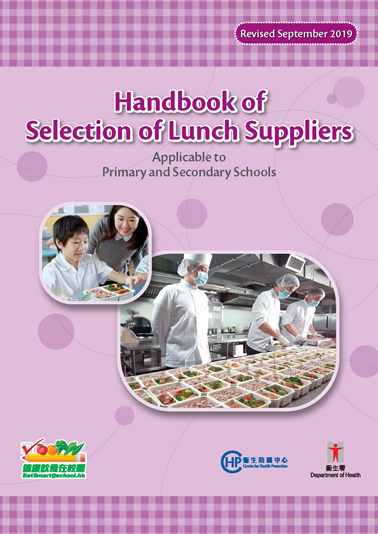With increasing popularity of whole-day primary school, large numbers of children would have to take their lunch at school every day. As contracts made with lunch suppliers usually spans for at least one academic year (and up to three years), choosing an appropriate lunch supplier becomes an important task for primary schools.
It is very common for schools and parents to choose their school lunch supplier based on factors like scales of suppliers, performance, food hygiene, plant visit, tasting session and prices. In fact, it is also important to consider suppliers’ ability to provide lunches with nutritional value as well as their promotion in environmental protection. Upon consultation with relevant stakeholders, the Department of Health (DH), the Education Bureau (EDB) and related stakeholders have together developed a "Handbook of Selection of Lunch Suppliers" for school reference. Supplemented by regular lunch monitoring tools, the DH hopes that lunch provided for school children could be both nutritive and value for money.
This latest version is revised to incorporate the latest comments as collected by DH from schools and school lunch suppliers. Apart from DH, the EDB, the Environmental Protection Department (EPD), the Food and Environmental Hygiene Department (FEHD), the Independent Commission Against Corruption (ICAC), and others may also revise their notices and guidelines from time to time, so schools should also note the most updated information from these bodies when choosing their lunch suppliers. Schools are welcome to take reference from the proposed flow charts and templates in this handbook, formulate their internal guidelines of lunch supplier selection, and practise healthy eating in schools.

Handbook of Selection of Lunch Suppliers (The latest version)
Foreword
Chapter I: Procedures of Selecting School Lunch Suppliers
Chapter II: FAQs
Chapter III: Laws, Circulars and Guidelines
Chapter IV: Reference Documents
Appendix (Updated in April 2024)
In case of any discrepancies between the Chinese and the English versions, the Chinese version shall prevail.
Note: To provide better service, we will update our webpage from time to time. Some of the hyperlinks quoted in the Handbook may no longer be valid or need further supplement. Please refer to this document for details.
|
|

